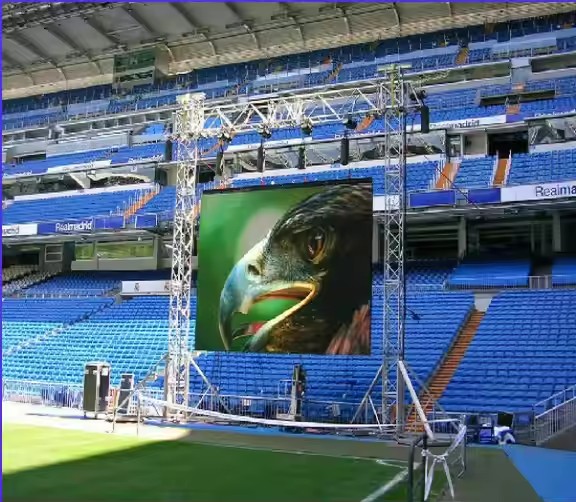
Stadium LED display applications.
Introduction
The 2024 UEFA European Championship and Copa América are scheduled very closely. These two football feasts give fans the opportunity to watch two finals on the same day and enjoy double the joy of football. At that moment, the world’s eyes are focused on the same green field. With the help of LED display as carrier, more delicate and high definition wonderful pictures are presented to the majority of fans in various forms. With the conclusion of these two major events, this article will sort out and inventory the close relationship between sports and LED display in Sports Venues.

In the Stadium: Enhancing Smart Venue Upgrades
The application of LED displays in sports venues settings is divided into indoor and outdoor, enhancing not only the viewing experience but also the commercial value and interactivity of sports events.
In outdoor stadiums, LED displays are widely used in the entrance and exit of venues, ticket windows, press conferences, stadium fences and spectator stands. Among them, fence screens, grandstand screens and score screens are favored because of their crucial roles in the transmission of event information and the improvement of the audience experience.

In indoor stadiums, LED display in sports venues cover venue entrances, field ceilings, press conference sites, field perimeters, and spectator seats. These screens not only enhance the visual experience of the audience, but also provide an efficient platform for event promotion and information display.

Common LED screens in sports venues
Different screens have different requirements. Taking four types of screens commonly used in sports venues as examples:
Cube Screen: Resolution transitions from 4K to 8K. According to “Requirements and Inspection Methods for Sports Venue Equipment Part 1: LED Display Screens,” screen brightness is typically required to be ≥1000cd/㎡.
Stand Screen: Displays important match information, usually required to display 12 lines of characters, with character size calculated based on the scale and spatial dimensions of the sports venue.
Stand cornice screen: Usually consists of two to three layers, with front maintenance design, a height of 0.96 to 1 meter, spacing P6-P10, equipped with lighting control ports, used to enhance the atmosphere.
Main Stage Screen/Background Screen: Depending on the size of the stadium, it can be designed in a lifting mode, usually requiring a resolution of about 8K for large-scale performances.
Stadiums typically place more emphasis on the viewing experience, requiring high-definition, high-brightness, and interactive LED screens.

Live outdoor broadcast: Creating an Exciting Viewing Experience


The demand brought by sports events lies not only in the demand for stadium LED screens, upgrades and maintenance of the sports themselves, but also in the peripheral demand brought by sports and the demand for daily viewing, which basically depends on the commercialization of the event.
Sports are driving the growth of large LED screens, and the demand for comprehensive viewing brought by large-scale events such as the UEFA European Championship is directly driving the growth of large screens. In terms of backlighting, the market demand for Mini LED backlights is increasing, and brands are promoting the iteration of high-value-added products.
During the UEFA European Championship, CCTV Sports Channel launched a special program for the 2024 European Championship, “Football Feast.” The studio for this program, created by New Visual, utilized nearly 300㎡ of main screens and LED floors.

During the European Championship, many venues such as parks, bars, and malls used LED displays for live events. In addition, as LED cinema screens gradually enter theaters, they have spawned new business models such as “cinema+”, providing fans with more ways to watch matches.
Development prospects of large sports LED screens
From the perspective of large screens, with technological advances, the opening ceremonies of multiple sports events have long adopted XR virtual shooting.
The development of sports LED displays still focuses on the commercialization of sports events. In recent years, with the change of consumption structure, the commercialization of many events has accelerated, and the demand for more and more specialized LED displays has also increased.
2024 It’s a big year for sports, with events like the World Cup, Olympics, and French Open intermingling, driving a surge in demand. As a carrier for event broadcasting and surrounding promotional activities, LED displays will greatly benefit.
Conclusion: Future prospects of LED displays
The wide application of LED display technology in sports events not only enhances the viewing experience of the audience, but also promotes the commercialization process of the sports industry. With continuous technological advances and innovations in business models, LED displays will play an increasingly important role in future sports events. Whether in-stadium applications or outside broadcasts, LED displays will become an essential key element, bringing more exciting and stunning visual feasts to global audiences. Looking ahead, LED display technology will continue to break through and innovate, helping sports events reach new heights.